by Helen Kurdadze
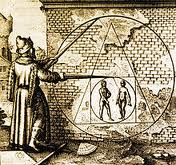 The process of preparation of “Philosopher’s Stone” has been a great mystery in all epochs. Apart from chemical operations it encompassed the spheres of mysticism as well. Through the process it was possible to turn metal into gold as well as improve human’s physical and spiritual state. At the same time, the owner of a “Philosopher’s Stone” would become very rich and powerful and that is why alchemy was called a royal art in old times.
The process of preparation of “Philosopher’s Stone” has been a great mystery in all epochs. Apart from chemical operations it encompassed the spheres of mysticism as well. Through the process it was possible to turn metal into gold as well as improve human’s physical and spiritual state. At the same time, the owner of a “Philosopher’s Stone” would become very rich and powerful and that is why alchemy was called a royal art in old times.
Alchemy, as well as blacksmithing is the art originated within the traditions of agriculture. The farmer is the one who has good knowledge of geological materials and deposits and the qualities of metals in the mines of the earth. The farmer knows well what relates these metals with plants growing on the surface of the earth and the planets moving in the sky.
Perhaps this is why old alchemists identified the work of alchemy with land cultivating. As Fulcannelli puts it “Alchemy is often referred to as heavenly farming, as alchemist’s work by its rules, circumstances and conditions is very similar to peasant’s work. There is no classical hermetic author who has not produced examples and proofs from agriculture sphere”.
According to old Greek references, one of the first alchemic tractate was written on the Golden Fleece. It is also noteworthy that Jason was given an “agricultural” task to carry out. On a Martian field he had to plough the land with fire-breathing bulls, plant dragon’s teeth and fight the armed warriors that would sprang out of the field he had sown. Nicolas Flamel considers this task as an alchemic process and Fulcanelli writes that “The myth about Golden Fleece is the detailed description of alchemic work which leads us to obtaining philosopher’s stone”.
Probably the story of Argonauts is alchemists’ favorite one as the fleece contained formulae. But nobody says anything about what the fleece looked like, or where it finally occurred after the Argonauts had got hold of it. But the thing of such significance can’t have been disappeared without any trace.
If we want to find the Fleece we should search for the thing the information on which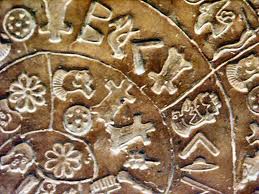 most of all looks like alchemic symbols. In one of the museums of Greece, there is indeed kept a thing like this. On theisland of Crete, during the excavation of Phaestos palace, archeologists found a disk, which later they called “Phaistos Disk”. It has been considered one of the most interesting discoveries of all times and is a certain intellectual puzzle.
most of all looks like alchemic symbols. In one of the museums of Greece, there is indeed kept a thing like this. On theisland of Crete, during the excavation of Phaestos palace, archeologists found a disk, which later they called “Phaistos Disk”. It has been considered one of the most interesting discoveries of all times and is a certain intellectual puzzle.
The disk has lots of printed small pictures on it and is very much like “Khevsurian pie”. Some scholars think it is a game-board, in others’ opinion it is a calendar, one even called it a computer of Bronze Age. There were lots of attempts to decipher the disk in many languages, but none has been proven scientifically.
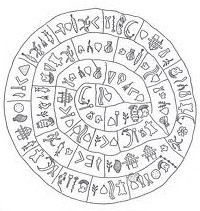 But still, what information is hidden on Phaistos Disk? In the first place we should note the unity of paintings, the general scheme depicts a coiled serpent whose body has such a configuration that a head overlaps the tail, i.e. symbolically it represents an “Ouroboros”- it is the serpent swallowing its tail- the symbol of “eternal re-birth”. This sign indicates that the end of way means the beginning of a new way. This is the same as circle – the metaphor of time rotation, a cyclical repetition – the idea of creating new from old (in this case, the symbol of eternal life). This sign is especially popular in alchemy. Alchemists say that Ouroboros epitomizes inwardness and recurrent processes, which by warming up the liquid, its evaporation and condensation favors the refinement of the substance.
But still, what information is hidden on Phaistos Disk? In the first place we should note the unity of paintings, the general scheme depicts a coiled serpent whose body has such a configuration that a head overlaps the tail, i.e. symbolically it represents an “Ouroboros”- it is the serpent swallowing its tail- the symbol of “eternal re-birth”. This sign indicates that the end of way means the beginning of a new way. This is the same as circle – the metaphor of time rotation, a cyclical repetition – the idea of creating new from old (in this case, the symbol of eternal life). This sign is especially popular in alchemy. Alchemists say that Ouroboros epitomizes inwardness and recurrent processes, which by warming up the liquid, its evaporation and condensation favors the refinement of the substance.
One of the old alchemic texts, which is also contained on the disk, is very similar to Phaistos Disk. It belongs to an alchemist woman – Cleopatra who lived in Alexandria, Egyptin the IV century, who says: “One is all, of him is everything, for him is everything, in him is everything. The snake is the one; it has two symbols, good and evil.”
The text speaks exactly about Ouroboros which is represented in alchemic paintings by two dragons. As Nicolas Flamel writes: “Consider these two dragons, for they are the true beginnings of philosophy which the sages were not permitted to show their children. The one at the bottom is called the fixed and constant or the man. But the upper snake is the volatile or black, dark woman. The first is called sulphur or the warm and dry. The other is called quicksilver or the cold and moist”.
The same two principles are depicted on the sides of the disk. One side in the centre of which shows a rosace corresponding to fire – denotes “dry” substance, and the other showing water exactly corresponds to “wet” principle.
The oldest alchemic text – Emerald Tablet of Hermes – also tells us of one origin of these two alchemical symbols and hence, corresponds to the scheme of Phaistos Disk. The link with this text is also apparent from the fact that both sides of Phaistos disk are divided into equal number of squares -30 squares on each side. 32 signs are used on each side to convey information; the centre is marked on both sides, so we can say that the configurations of upper and lower parts are the mirror reflection of each other which is the direct illustration of the “Emerald Tablet”.
“That which is above is also that which is below, for the performance of the wonders of a certain one thing, and as all things arise from one Stone, so also they were generated from one common Substance, which includes the four elements created by God. And among other miracles the said Stone is born of the First Matter.”
Now let us try to interpret Phaistos Disk paintings without violating the common law by touching upon the mystery which the alchemists neither wrote nor talked about overtly. As alchemists kept many things in secret, they often resorted to allegorical pictures to communicate the text. A famous alchemist Flamel also called his alchemical tractate that was made up of pictures “Hieroglyph figures”. Also alchemical information in one of the old books “Mutus Liber” is conveyed through pictures and it was called the book for the mute as it did not contain any texts. The most part of the text was also done in pictures in the old book which is thought to have been discovered by Flamel. That is why alchemists’ work is called a rebus, i.e. pictorial puzzle. Realistic nature of Phaistos Disk also indicates the fact that they are hieroglyphs of the alchemical “rebus”, i.e. the story told in a universal language – the language of symbols. Along with this, the pictures are arranged in such order that their succession – tells a concrete “history”.
Despite the fact that the pictures are very small, they are accompanied by specific details, i.e. each picture contains implications, subtexts and has several meanings (Nicolas Flamel also writes that the greatest secret is hidden in most unimportant and small hieroglyphic figures). It is also interesting that only 45 signs are used for conveying information- 32 on each side, which is too few for syllabic script. In this case it would be a phonetically poor text, while the pictures are so rich in ideas that they give ample possibilities for interpretation.
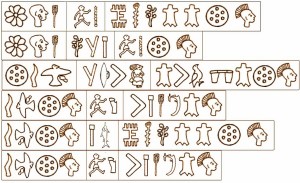 According to Georg von Welling, if we throw a little piece of a “philosopher’s stone” onto the surface of the water, it will repeat a miniature model of the history of world creation and development. Creation of the world implies in itself creation of a human being. Thus alchemical process corresponds to the act of creation and suggests the allegory of Adam’s birth. The pictures on the disk tell us about alchemical myth of a first man –“the little king’ (as called by alchemists): his birth in the garden, his material “embodiment”, his expulsion from the paradise, his fall, the flood, further history and finally coming down to the original status –i.e. return to paradise.
According to Georg von Welling, if we throw a little piece of a “philosopher’s stone” onto the surface of the water, it will repeat a miniature model of the history of world creation and development. Creation of the world implies in itself creation of a human being. Thus alchemical process corresponds to the act of creation and suggests the allegory of Adam’s birth. The pictures on the disk tell us about alchemical myth of a first man –“the little king’ (as called by alchemists): his birth in the garden, his material “embodiment”, his expulsion from the paradise, his fall, the flood, further history and finally coming down to the original status –i.e. return to paradise.
This scheme generally represents the psychological scheme of mankind and epitomizes the image of the collective unconscious. It is interesting that the whole history depicts the process of obtaining philosopher’s stone. In Georgian folklore the same allegory is known under the name of “Amiran’s Myth”. Its plot directly features alchemical operations.
But where should we start reading the text on the disk? It is interesting that the whole scheme expresses the serpent’s body whose tail and head are both in the center. Presumably we should start reading the text from the centre. Mythological information will help us from which side to start. In the folklore, the serpent is the guard of treasure or the owner of a precious stone and in often cases it has the stone either in the mouth or it crowns its head. The ultimate goal of alchemical operations is obtaining the precious stone and as it is fixed at the head, then we should suppose that the text containing alchemical operation should be read from the opposite side, i.e. from the centre of the other side.
On this place of the disk there is a rosace. This symbol denoting fire and planet is the most important sign, as the rosace, (in the shape of a star) in the work of alchemists means the start of a new stage (their arrangement on a disk gives different schemes which helps us to arrange the pictures in the order. Apart from the central one, the disk has three other rosaces, corresponding to three main stages of alchemical work. (We will only look at two schemes).
 The rosace epitomizes a monad, the original essence, planetary space from where the Mind comes down. Flamel says: “Rosace – the antimony of the sage is the chaos from which all metals are born; it is the flower of metal and mineral, the first rose which exists in our world. Among these flowers we distinguish the mind, which during the act of creation was drifting on waters. Shining with white light it represents the luster of stars, the sun light. The sage’s antimony (and not ordinary one) is the root or the stem of the great work»
The rosace epitomizes a monad, the original essence, planetary space from where the Mind comes down. Flamel says: “Rosace – the antimony of the sage is the chaos from which all metals are born; it is the flower of metal and mineral, the first rose which exists in our world. Among these flowers we distinguish the mind, which during the act of creation was drifting on waters. Shining with white light it represents the luster of stars, the sun light. The sage’s antimony (and not ordinary one) is the root or the stem of the great work»
This wonderful solar energy that occurred on the earth (as a ray) will penetrate the seed, the wheat and this seed in the soil will grow out of the land as a plant, as an androgenic first human, androgenic Adam born from the earth –Mercury, symbolically expressed with the signs of the “sun” and “moon”. In this symbol, the shield (moon ) – is a passive object and epitomizes the female origin and corresponds to the “soul”, the man’s head (the sun) – symbolizes the mind, the masculine, active principle. (The man’s name in Greek is “Spartan” – “sown”). It is interesting that the shield was the main relic for a Spartan warrior.
We come across these warriors in the field ploughed by Jason i.e. in this case agricultural allegory and warriors with the shield born from the earth are unified. Both of these alchemic plots are given on the Phaistos Disk.
Flamel writes the following about this androgenic symbol–“this substance appears as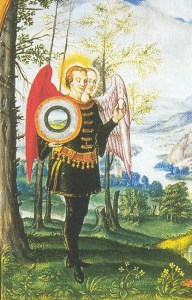 a royal triumph, it is the moon and a small, imperfect king, who through our philosophic art must be raised to the highest rank of glory. It is at the same time the Queen epitomizing – the sun’s wife, as it contains, both yang and yin”. The fetus of the Mind coming down from the above some time later gets mature, which means that it is already fit for work. It is on a slow fire and “anima” evaporates from it under the image of a bird (pigeon or eagle), i.e. it is separated, a feminine (tender) substance secedes from it, that is why a woman’s picture comes into view. This substance should become equal in its “weight” to the primary substance, that is why the skins are already separated and between them the sign of scales appears. One of the alchemical laws says about the above: “We start hermetical work by unifying “three principles”, which should be taken in three proportions, which means that the half of the weight of the body must be balanced by Mind and Soul”.
a royal triumph, it is the moon and a small, imperfect king, who through our philosophic art must be raised to the highest rank of glory. It is at the same time the Queen epitomizing – the sun’s wife, as it contains, both yang and yin”. The fetus of the Mind coming down from the above some time later gets mature, which means that it is already fit for work. It is on a slow fire and “anima” evaporates from it under the image of a bird (pigeon or eagle), i.e. it is separated, a feminine (tender) substance secedes from it, that is why a woman’s picture comes into view. This substance should become equal in its “weight” to the primary substance, that is why the skins are already separated and between them the sign of scales appears. One of the alchemical laws says about the above: “We start hermetical work by unifying “three principles”, which should be taken in three proportions, which means that the half of the weight of the body must be balanced by Mind and Soul”.
It is followed by the operation with fire, from which, by heating it again the existing agent is seceded from it as a bird, and by cooling it – it goes back. The operation is repeated three times and is called sublimation. Fulcanelli writes: “The process of obtaining mercury of the sage is called sublimation as its main condition is the detachment of a thin substance from the solid one, which goes up. Our soul, the medium, plays here the role of an eagle symbolically, that snatches its victim and that’s why Philalet, Cosmopolite and others advise us to let it to go up, make it soar in the air. It is known that the soul goes up and the substance sedimentates. What is cream if not the best part of the milk?”
Vasili Valentini teaches us that “philosopher’s stone is obtained in the same way as butter, by beating up cream which resembles our philosophical mercury, that is why mercury is also called the maiden’s milk”. (The excrete sediment is depicted on the Phaistos disk under the image of a bull’s leg as a heavy, earth sign, and the thickened, coagulated substance that is floating above – is shown as ship).
“If it be transmuted into earth, then the earth separates from the fire, that which is most subtle from that which is hard, operating gently and with great artifice. Then the Stone ascends from earth to heaven, and again descends from heaven to earth, and receives the choicest influences of both heaven and earth. If you can perform this you have the glory of the world, and are able to put to flight all diseases, and to transmute all metals” –
says the “Emerald Tablet” and these words precisely describe this operation. Thus, constant distillation and unification of a solid substance with the soaring substance, the first slogan of alchemists “solve et coagula” (dissolve and coagulate) is expressed. The substance turns into Mind and the metal soul, quitting the polluted membrane clothes in a more precious, valuable substance, which the old authors called “philosophical mercury”. It is very interesting that we come across the same operation in the myth about Amiran but in a slightly altered version.
The process in this myth is described as follows: “Sulkalmakhi put the newly-born Amiran in the cradle, put a book on his chest and put the cradle on the junction of three roads. The abandoned infant was crying bitterly, and the voice of his crying reached the God in heaven who sent the raven to the earth to find out what was going on. The raven came down to the earth and poked his one eye out, went back to heaven and told the God that nothing was happening; just people were making a noise. The baby was crying and crying again, day and night. This time the God sent a crow that did the same – poked the other eye out and flew back to the heaven. The God grew anxious and now he sent the pigeon who swiftly came down to the earth, approached the cradle, read the letter on the chest of the infant, dipped the feet in the blood, flew to the heaven and told the God everything that was happening. After this, the God himself came down. He came up to the cradle, cut an apple in two, and put the halves into his eyes. The baby started to see. He looked at the white bearded old man and smiled”.
In this story the cradle epitomizes the “moon” where there is the small “sun” and above and below there are the birds – here the agent substance is implied which is excreted in the process of this operation. It is interesting that in this myth as well as in the text on Phaistos Disk, this process is repeated three times. The junction of three roads – is the sign of fire of a certain regime, with the cradle in the centre. The new eyes granted by the God indicate the improved quality of the “matter” and correctly conducted work.
above and below there are the birds – here the agent substance is implied which is excreted in the process of this operation. It is interesting that in this myth as well as in the text on Phaistos Disk, this process is repeated three times. The junction of three roads – is the sign of fire of a certain regime, with the cradle in the centre. The new eyes granted by the God indicate the improved quality of the “matter” and correctly conducted work.
Afterwards, little baby Amiran, wrapped in leather is drifted into theBlack Sea. Once Amiran’s brothers, Badri and Usup go into the deep sea to fish and see an island there. At this time a bull and a cow swim to the island and from the middle of the sea a little child jumps out who is all gold above the waist and silver below. He has a picture of the sun on one shoulder and of the moon on the other. The boy goes to the cow, sucks the milk, then jumps onto the bull’s back, stood between his horns and starts to dance.
The episode in the sea is an overtly described alchemic stage, where Amiran is explicitly mentioned as an alloy of gold and silver, the amalgam, which when coagulated, comes to the surface of the newly created substance on the top of the liquid (the island) and is fed by cow’s milk – the sign of earth, then dances between the horns of the bull (the moon). This stage reflects the first thickening of a stone that emerged from the mercury, as of a stone in its earlier stage which is still “infant” and needs to be fed with “milk”. I.e. On Phaistos Disk, as well as in Amiran’s story, two main alchemical operations are given: sublimation and coagulation.
We come across the same operation in the Bible, in Noah’s story – after heavy rain and storm, when it clears up, the water level goes down and Noah’s Arc is stranded on the top of the mountain. Noah, who survives sends ravens from his Arc twice and the third time he sends out the pigeon that comes back with good news with the branch of olive tree in its beak. After that Noah comes out of the Arc and in token of survival and a new covenant he sees a rainbow in the sky, which indicates that the most complicated operation has been successfully accomplished.
In this case, the Arc floating in the sea that rain had created, stranded on the peak of the mountain coming out of the water, i.e. the island (the mountain peak coming out of the water) that was obtained as a result of drying (coagulation); after emitting the agent under the image of a bird, when at the third attempt the substance becomes white (pigeon), Noah leaves its old membrane – the Arc and goes into a renewed world.
© 2006
